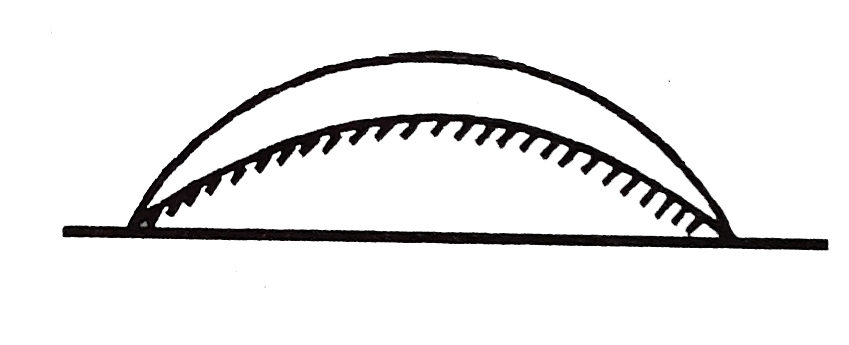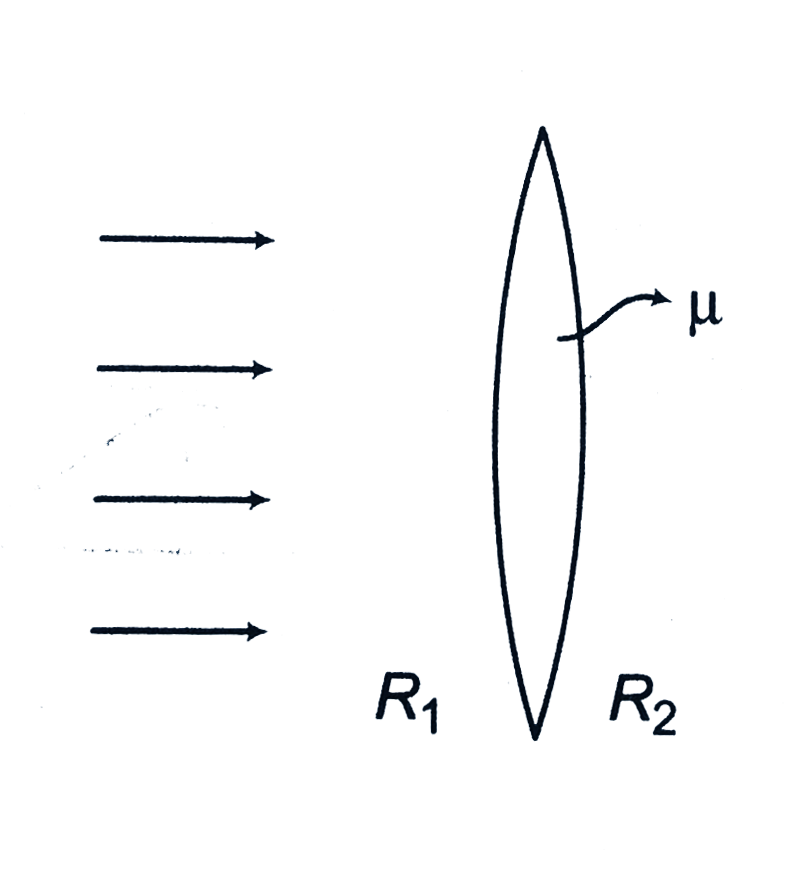A convex lens of radii of curvature 20cm and 30 cm respectively. It is silvered at the surface which has smaller radius of curvature. Then it will behave as (μg=1.5)
concave mirror with equivalent focal length 3011cm.
concave mirror with equivalent focal length 6011cm.
convex mirror with equivalent focal length 3011cm.
convex mirror with equivalent focal length 6011cm.
The correct Answer is:B
To solve the problem step by step, we will follow the principles of optics related to lenses and mirrors. Here’s the detailed solution:
Step 1: Identify the given data
- The radii of curvature of the convex lens are:
- R1=20cm (for the first surface)
- R2=−30cm (for the second surface, negative because it is a convex lens)
- The refractive index of the glass is μg=1.5.
Step 2: Use the lens maker's formula
The lens maker's formula for a lens is given by:
1FL=(μg−1)(1R1−1R2)
Substituting the values:
1FL=(1.5−1)(120−1−30)
This simplifies to:
1FL=0.5(120+130)
Step 3: Calculate the terms inside the parentheses
First, find a common denominator for 120 and 130:
- The least common multiple of 20 and 30 is 60.
- Thus, we have:
120=360,130=260
Adding these gives:
120+130=360+260=560
Step 4: Substitute back into the lens formula
Now substitute back into the lens maker's formula:
1FL=0.5⋅560=5120=124
Thus, the focal length of the lens is:
FL=24cm
Step 5: Find the focal length of the silvered surface
Since the lens is silvered at the surface with the smaller radius of curvature (20 cm), we treat it as a plane mirror. The focal length of a plane mirror is given by:
FM=−R2=−202=−10cm
Step 6: Calculate the equivalent focal length
The equivalent focal length Feq of the system (lens + mirror) is given by:
1Feq=1FL+1FM
Substituting the values:
1Feq=124+1−10
Finding a common denominator (120):
1Feq=5120−12120=−7120
Thus, the equivalent focal length is:
Feq=−1207≈−17.14cm
Step 7: Interpret the result
Since the equivalent focal length is negative, the system behaves like a concave mirror.
Final Answer
The system behaves like a concave mirror with an equivalent focal length of −1207cm.
- The radii of curvature of the convex lens are:
- R1=20cm (for the first surface)
- R2=−30cm (for the second surface, negative because it is a convex lens)
- The refractive index of the glass is μg=1.5.
The lens maker's formula for a lens is given by:
1FL=(μg−1)(1R1−1R2)
Substituting the values:
1FL=(1.5−1)(120−1−30)
This simplifies to:
1FL=0.5(120+130)
First, find a common denominator for 120 and 130:
- The least common multiple of 20 and 30 is 60.
- Thus, we have:
120=360,130=260
Adding these gives:
120+130=360+260=560
Now substitute back into the lens maker's formula:
1FL=0.5⋅560=5120=124
Thus, the focal length of the lens is:
FL=24cm
Since the lens is silvered at the surface with the smaller radius of curvature (20 cm), we treat it as a plane mirror. The focal length of a plane mirror is given by:
FM=−R2=−202=−10cm
The equivalent focal length Feq of the system (lens + mirror) is given by:
1Feq=1FL+1FM
Substituting the values:
1Feq=124+1−10
Finding a common denominator (120):
1Feq=5120−12120=−7120
Thus, the equivalent focal length is:
Feq=−1207≈−17.14cm
Since the equivalent focal length is negative, the system behaves like a concave mirror.
The system behaves like a concave mirror with an equivalent focal length of −1207cm.
Topper's Solved these Questions
- BOOK - NCERT FINGERTIPSCHAPTER - RAY OPTICS AND OPTICAL INSTRUMENTSEXERCISE - Refraction Through A Prism9videos
RAY OPTICS AND OPTICAL INSTRUMENTS
- BOOK - NCERT FINGERTIPSCHAPTER - RAY OPTICS AND OPTICAL INSTRUMENTSEXERCISE - Some Natural Phenomena Due To Sunlight2videos
RAY OPTICS AND OPTICAL INSTRUMENTS
- BOOK - NCERT FINGERTIPSCHAPTER - RAY OPTICS AND OPTICAL INSTRUMENTSEXERCISE - Total Internal Reflection7videos
RAY OPTICS AND OPTICAL INSTRUMENTS
- BOOK - NCERT FINGERTIPSCHAPTER - PRACTICE PAPPEREXERCISE - Practice Paper 350videos
PRACTICE PAPPER
- BOOK - NCERT FINGERTIPSCHAPTER - SEMICONDUCTOR ELECTRONICS : MATERIALS , DEVICES AND SIMPLE CIRCUITS EXERCISE - Assertion And Reason15videos
SEMICONDUCTOR ELECTRONICS : MATERIALS , DEVICES AND SIMPLE CIRCUITS
Similar Questions
Knowledge Check
- Question 1 - Select One
A concave lens has radioi of curvatures of 20 cm and 30 cm respectively. If the refrative index of the material of lens is 1.6 it focal length is given by
A−30 cmB−25cmC−20cmD−10cm - Question 2 - Select One
A concavo-convex glass (index=1.5) lens has radii of curvatures 60cm and 40cm, respectively. Its convex surface is silvered , and its placed on a horizontal table with concave surface up. The concave surface is then filled with a liquid of index 2.0. The combination behaves like
AConcave mirrorBConvex mirrorCFlat mirrorDConvex lens - Question 3 - Select One
The concave surface of a thin concavo-convex lens of index1.5has radius of curvature 50cm and10cm respectively.The concave side is silvered andplaced on a horizontal surface as shown

Focal length of silvered lens is:A30cmB25cmC15cmD10cm
The concave and convex surface of a thin concavo-convex lens of refractive index 1.5 has radius of curvature 50 cm and 10 cm respectively. The concave side is slivered then if the equivalent focal length of the silvered lends is −5xcm then find x.
View SolutionThe convex surface of a thin concavo-convex lens of glass of R.l. 1.5 has a radius of curvature 20 cm. The concave surface has a radius of curvature 60 cm. The convex side is silvered and placed horizontally.
Q Where should a pin be placed on the axis such that its image is formed on the same point. View Solution
View SolutionThe concave surface of a thin concavo-convex lens of index1.5has radius of curvature 50cm and10cm respectively.The concave side is silvered andplaced on a horizontal surface as shown

Focal length of lens(without silvered)is:View SolutionA thin plano-convex lens acts like a concave mirror of radius of curvature 20cm when its plane surface is silvered. The radius of curvature of the curved surface if index of refraction of its matarial is 1.5 will be
View SolutionIf the plane surface of a plano-convex lens of radius of curvature R and refractive index μ is silvered, then its focal length would be
View Solution


